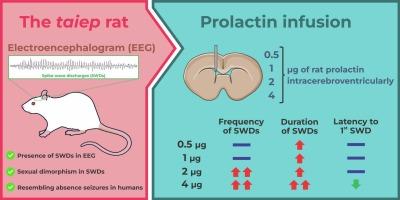Exacerbation of absence seizures by central prolactin in female taiep rats: An animal model of epilepsy-prone leukodystrophy
IF 2.3
3区 医学
Q2 BEHAVIORAL SCIENCES
引用次数: 0
Abstract
Absence seizures are a type of generalized epilepsy characterized by spike-wave discharges (SWDs) in the electroencephalogram (EEG). This condition affects girls more frequently than boys and has a worse prognosis in women during puberty and adulthood. These characteristics of sexual dimorphism and age predominance could be attributed to changes in plasma hormone levels during development, particularly during puberty, which can modulate the cortico-thalamic circuit responsible for generating and sustaining SWDs. Prolactin is a peptide hormone secreted by adenohypophysis, exhibits sexual dimorphism and undergoes an increase during puberty. In this study, we employed female taiep rats, a well-validated animal model of leukodystrophy known as hypomyelination with atrophy of the basal ganglia and cerebellum (H-ABC). This model has a sexually dimorphic pattern of SWDs, with males exhibiting greater susceptibility to the condition. The rats were ovariectomized and electrodes were implanted for EEGs and a stainless-steel cannula for administration of rat prolactin via intracerebroventricular (i.c.v.) injection. Five 12-hour EEGs were performed with fixed 48-hour start intervals: the control EEG followed by i.c.v. prolactin administration at doses of 0.5, 1, 2, or 4 μg/2 μL. The frequency of SWDs increased significantly with the 2 and 4 μg/2 μL doses of prolactin. The mean duration of SWDs increased significantly with all doses evaluated, with the greatest effect observed 6 h after 4 μg/2 μL of prolactin, which doubled the mean duration obtained in control conditions. Additionally, prolactin 4 μg/2 μL significantly decreased the latency to the first SWDs. We propose that prolactin is capable of neuromodulating the thalamo-cortical circuit responsible for spike-wave discharges.

中枢性催乳素对雌性睡眠大鼠癫痫发作的加重作用:癫痫易感性脑白质营养不良动物模型。
失神性癫痫是一种全身性癫痫,其特征是脑电图中的尖波放电(SWDs)。这种情况在女孩中比男孩更常见,在青春期和成年期的女性中预后更差。这些性别二态性和年龄优势的特征可能归因于发育过程中血浆激素水平的变化,特别是在青春期,这可以调节负责产生和维持SWDs的皮质-丘脑回路。催乳素是一种由腺垂体分泌的肽激素,表现出两性二态性,并在青春期增加。在这项研究中,我们使用了雌性大鼠,这是一种经过验证的脑白质营养不良的动物模型,称为基底节区和小脑萎缩的髓鞘退化(H-ABC)。该模型具有性别二态的SWDs模式,男性表现出更大的易感性。切除大鼠卵巢,植入脑电图电极和不锈钢套管,通过脑室内注射大鼠催乳素。5个12小时脑电图,固定48小时开始间隔:对照脑电图,然后以0.5、1、2或4 μg/2 μL剂量给药催乳素。泌乳素2、4 μL /2 μL剂量组SWDs发生率显著升高。在不同剂量下,SWDs的平均持续时间均显著增加,在4 μg/2 μL催乳素后6 h效果最大,是对照组平均持续时间的两倍。泌乳素4 μg/2 μL可显著降低小鼠到第1期SWDs的潜伏期。我们提出催乳素能够神经调节丘脑-皮层回路负责尖波放电。
本文章由计算机程序翻译,如有差异,请以英文原文为准。
求助全文
约1分钟内获得全文
求助全文
来源期刊

Epilepsy & Behavior
医学-行为科学
CiteScore
5.40
自引率
15.40%
发文量
385
审稿时长
43 days
期刊介绍:
Epilepsy & Behavior is the fastest-growing international journal uniquely devoted to the rapid dissemination of the most current information available on the behavioral aspects of seizures and epilepsy.
Epilepsy & Behavior presents original peer-reviewed articles based on laboratory and clinical research. Topics are drawn from a variety of fields, including clinical neurology, neurosurgery, neuropsychiatry, neuropsychology, neurophysiology, neuropharmacology, and neuroimaging.
From September 2012 Epilepsy & Behavior stopped accepting Case Reports for publication in the journal. From this date authors who submit to Epilepsy & Behavior will be offered a transfer or asked to resubmit their Case Reports to its new sister journal, Epilepsy & Behavior Case Reports.
 求助内容:
求助内容: 应助结果提醒方式:
应助结果提醒方式:


